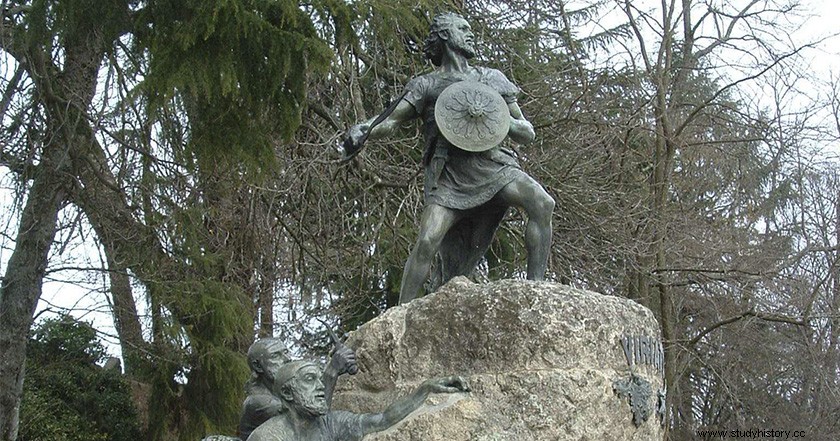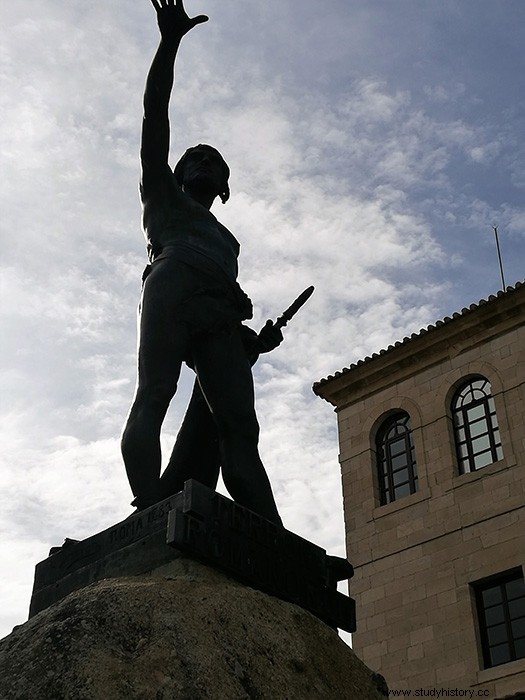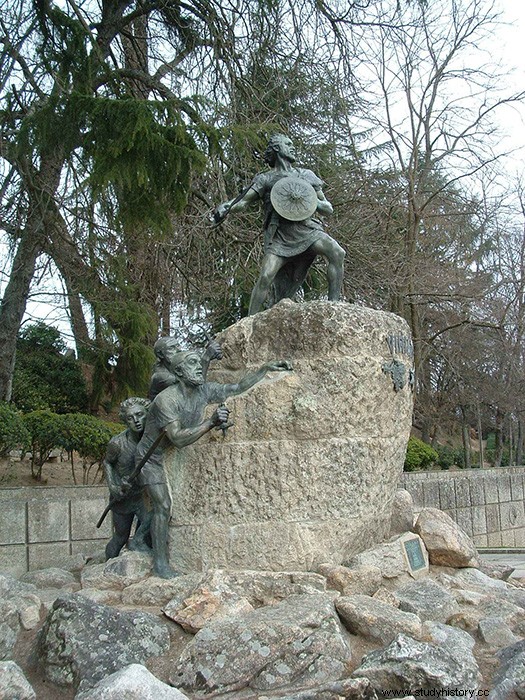
The story of Viriatus is the story of the hero that each town needs to maintain the memory of its origins. Although sometimes it is easy to think that it is also the history that Rome needed, to magnify the conquest of the most valuable territory that it achieved in its thousand years of history. Personally I think it is an exciting story, halfway between reality and fiction, so it is extremely difficult to find the border between one and the other. What we know evidently comes to us through the eyes of his opponents. It only remains for me to add before starting, that I was delighted to come across this story again on my only visit to that wonderful city that is Zamora.

Viriato in Zamora
Lusitania, year 151 BC
At the same time that a group of Lusitanians were returning from their last plunder of wheat to their Vaccean neighbours. Servius Sulpicio Galba , the legacy of Rome, hatched a plan to put an end to the usual riots of the Lusitanians in the territories protected by Rome. It is clear that they knew very well the needs of the people descended from the Celts. Its territory, rich in minerals, did not offer the best conditions for agriculture. Their way of life linked to the world of livestock, especially horses, needed large pastures, and the wild mountains were not the best place to plant cereals. Possibly they were not the best merchants, hence they needed the raids between the Vacceos, the Vetones, or the Carpetans, to get hold of their grain.
Galba proposed to the Lusitanians to settle in three fertile border areas. There the Roman legions had to collaborate in the construction of new cities, and provide them with good communications, the supposed Romanization of the Lusitanians was underway. On the proposed day three great Lusitanian tribes separated into the three proposed territories. It's hard to believe what happened next; the Romans asked the Lusitanians to lay down their arms; “a peasant does not need them ”. Strangely, they agreed, we can only imagine that they thought that they would be returned to them later. The next order was to kill everyone, men, children, women or the elderly. The action was repeated in the other two proposed places.
Servius Sulpucio Galba had just tarnished the name of Rome. The Roman senate was deeply ashamed, but money is everything, with it he bought the pardon of the senators of Rome. But what he could not buy is the reaction of the Lusitanians, that same day from among the executed tribes or from one nearby, a man named Viriato, decides to oppose the Roman conquest of Hispania. According to some he was a humble shepherd, according to others he must already have some kind of position within the warrior establishment. He doesn't care if he was in the Galba massacre, or he wasn't. It was not necessary to deeply hate the Roman people.
Four years later in a place in Turdetania.
Year 147 BC C. At that time the ancient Turdetania, which the Romans called Baetica in honor of the great river Betis that crossed it, it was defended by the praetor Cayo Vetilio. The defense was not in vain, since it was one of the most prosperous Roman regions, thanks to its mining, its agriculture and its trade possibilities through the river that we know today as Guadalquivir.

Viriatus' campaigns against Rome
10,000 Lusitanians dressed in light armor, Celtiberian-type shield, their small spear and their inseparable falcata, were preparing the assault on some rich Turdetan city. Possibly without realizing that another 10,000 Roman legionnaires had them practically surrounded. Without a doubt, anyone could remember what happened four years before, in short, the plan seemed the same. The Lusitanians, faced with the difficulties of fleeing from the place, decide to send two emissaries to negotiate a stable settlement. The proposal of the Romans was identical to the previous one. The Lusitanian chiefs discuss the possibilities, at which point the figure of Viriato emerges, of surrendering nothing, perhaps they did not remember what happened four years before.
The morning after the deliberations, 1,000 mounted Lusitanians stand before the Roman legions. They expect a frontal attack, but the Lusitanians have another plan. The men on foot behind the horses begin to flee from the place of conflict, the attempts of pursuit by the Romans are defended by skirmishes of the fast Lusitanian horses. For at least two days the Lusitanians played cat and mouse with the Roman troops. Just the time needed by the men on foot to prepare the hole in the vicinity of the city of Tríbola, unknown today. Now was the time to flee with the fast horses, the Romans could only follow their trail from afar. The ambush was well prepared, more than 4,000 Romans perished under the Lusitanian falcatas or plunged into the nearby ravines.
The rest fled to the city of Carpessos, where they hired 5,000 mercenary Celtiberians who suffered the same fate in their confrontation with the Lusitanians. Although this last part of the story makes waters due to the geographical aspect, we are left with the fact that at that time the Celtiberians had not started their fight against Rome, the only valid explanation for the story that Appian tells us. But the truth is that the Lusitanians had found a hero, and the Romans the ideal pretext to continue demanding money from the Roman Senate.
Viriatus the leader of the Lusitanians.
Certainly given the details that the Roman narrators of the conquest of Hispania left us, it is difficult to ascertain the moment when Viriato became the caudillo or military leader of the Lusitanos. But surely after the victory in Tribola, his figure came out stronger. Good faith of it was given to us by Diodorus, who narrated to us the imposing wedding of Viriato with the daughter of the powerful Astolpas, the luxury that he narrated to us of that ceremony, comes to point out, either the enormous economic power of the Lusitanians, or another time the aggrandizement of the rivals conquered by Rome.
The following years we find the Lusitanians roaming freely through large areas dominated by the Romans, the victories swung from one side to the other, but the Romans could not control the Lusitanian campaigns . In the year 146 a. C. while Viriato and his men sacked the south of the Tagus River, within the limits of the Celtic town of the Carpetani, Rome decided to send its two praetors to Hispania to finish off the Lusitanians. The result was the usual one, since the tactic used by Viriato always gave him his best results against the most numerous armies. That is to say, the meeting face to face, the corresponding flight and the massacre of the Roman legions. This time even on two occasions, since, after escaping in the south, they took shelter near the current Talavera de la Reina, to finish off a large part of the two legions sent.

Viriato and the Lusitanians in Viseu
It is evident that the most scathing criticism of the great enemy cannot be lacking in Roman sources. Roman historians describe Viriatus and the Lusitanians as excellent warriors, but also as cruel and ruthless killers. According to Sextus Julius Frontinus, in his work dedicated to the war tactics of both the Romans and their opponents, Viriathus, apart from looting the rest of the pre-Roman peoples, sought alliances to put an end to the Romans. The narrated event occurred after the last victory in Talavera de la Reina. Viriato, on his return to Lusitania, deviates north through the mountains of the Central System to make contact with the Arevaci, given their refusal, who preferred peace with Rome, and murdered children and women.
Only a year later Rome sent its first consul against Viriatus. The chosen one Fabio Máximo Emiliano , which, thanks to the resources obtained after annihilating Carthage, was able to command 15,000 infantry and 2,000 horsemen, who arrived in Urso in the summer of 145 BC. Far from attacking the Lusitanians directly, and despite the haste of the Roman Senate, he decides to wait a year that he spent training his young army. The result was as expected for Emiliano, he defeated Viriato in at least two of the cities controlled by the Lusitanian, who had no choice but to retreat positions. But Rome could not celebrate the victory, at the same time the news arrived from Segeda, the Celtiberians took up arms, an unexpected setback that would delay the conquest of Hispania.
Going back to the conflict with the Lusitanians, in the year 141 a. C. he arrives in Hispania Fabio Máximo Serviliano , at the head of the most powerful army that the Romans had destined to put an end to Viriato, he did not lack even elephants ceded by the new partner of Rome, Numidia. After defeating the Lusitanians, Fabio decides for the first time to break into their territory. In nearly 10 years of fighting, it was the first time that a large Roman army had entered Lusitanian territory. The first objective is the city of Erisana, which in a few days is besieged. Immediately afterwards, the Lusitanian leader not only raised the siege to which the city of Erisana was subjected, but after chasing the Romans he cornered them again. Serviliano without possibilities decides to surrender to his army, Viriato's surprising response was to ask him to return to Rome, so that it would recognize the independence of Lusitania, in exchange for becoming faithful allies.
The end of Viriatus.
Without a doubt we are entering fully into the most sadly known part of Viriato's history. We have to start by saying that Rome accepted the pact. That endless war had cost a lot of money and countless human lives. In spite of this, the Roman Senate was still divided, the wealthiest wished to continue the war, since the riches that arrived from Hispania could be put in danger with a nuisance nearby. Meanwhile, the lower layers continued to see how it was increasingly difficult to find men willing to lose their lives thousands of kilometers away.
The division was taken advantage of by one of the cruelest characters in the history of Rome. Quinto Servilio Cepión, brother of the defeated Servilian and successor of the same in Hispania, did not contemplate peace with Viriato. Upon his arrival in the Peninsula he began with the provocations to the Lusitanian leader, at the same time that he closed the possible exits of the Lusitania with the beginning of the reconstruction of the ancient Vía de la Plata.
We can think that in the year 139 a. C., the situation was very similar to before the last pact of Viriato with Rome. Although possibly with smaller armies on the part of the Lusitanians, or at least that makes us think Viriato's decision to send three men, in search of the renewal of the pact.

The death of Viriato according to José Madrazo
Three names; Audax, Ditalco and Minuro have gone down in history as the most infamous turdetanos. Who knows what they offered him in that sumptuous store in Caepio? The truth is that on their return to the Lusitanian camp they entered Viriato's tent, who slept with his usual armor. Even so, a dagger pierced his neck, it's hard to think that no one would realize it until the next morning, or maybe his people were already very tired of fighting. The assassins fled at night, no one saw them leave, they returned for their reward, but even that was denied.
"Rome does not pay traitors" is possibly just one more of the legends that surround Viriato's life. The truth is that Rome controlled Lusitania from that moment on, but it is also true that at the cost of turning Viriato into a myth for history. Especially in the face of the nationalism that emerged in the 19th century, today several regions of Portugal and Spain still claim to be the ones that saw the birth of Caudillo Viriato.
More info:
The enemies of Rome, Philip Matyszak, Ed. Oberon, 2005
The Roman conquest of Hispania, Javier Negrete, The Sphere of Books, 2018
